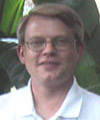Bob Yannes

Robert "Bob" J Yannes (born 1957) is an American electrical engineer.
Education[edit | edit source]
Yannes studied electrical engineering (EE) at Villanova University College of Engineering; he graduated in 1979 and also won the Professional Achievement award[2].
Early Life[edit | edit source]
Yannes started out as an electronic music hobbyist having been infatuated by electronic music since the early 1970s. He claims the song Lucky Man by Emerson, Lake & Palmer influenced him more than any other single song, and also lists Kraftwerk and Mike Oldfield among his influences[3].
MOS[edit | edit source]
Al Charpentier recruited Yannes as a chip designer at MOS Technology because his knowledge of music synthesis was deemed valuable for future MOS Technology/Commodore products.
Commodore[edit | edit source]
As a freshman engineer he designed the MicroPET, at home, and built a prototype with help from Al Charpentier. Jack Tramiel immediately wanted this prototype mass-produced following a demonstration at the 1980 CES. With additional components (BASIC, kernel, PETSCII character set, joystick interface and ROM user port) combined under the name of Project Vixen, the VIC-20 was born[4]. Yannes also influenced the later designs of Al Charpentier’s VIC.
He designed the single-chip sound synthesizer voice chip SID (6581) with enough resolution to produce high-quality music. However, he was unable to refine the signal-to-noise ratio which he desired. Time constraints also hindered the design of the multiplexed oscillators in the SID, which used a lot of chip area, and as a result only a few voices could be fitted on the chip. The SID chip was his first attempt at a phase-accumulating oscillator, the heart of all wavetable synthesis. He hoped the chip would find its way into polyphonic/polytimbral synthesizers[5].
Ensoniq[edit | edit source]
After he left MOS Technology he went on and co-founded Ensoniq in 1982 with Bruce Crockett, and Al Charpentier. Given less time constraints (than for the SID chip design) Yannes was able to implement a proper MOS Technology op-amp to eliminate signal leakage as well as incorporate an improved filter to achieve high resonance. The Ensoniq sound chips had multiplexed oscillators designed in such a way that it was possible to produce more voices per chip, typically 32 for Ensoniq's DOC, OTIS, and OTTO sound chips. Later designs include waveform interpolation, digital filters, and digital effects. In January 1998, Ensoniq Corp was acquired by Creative Technology Ltd for $77 million, and merged with E-mu Systems to form the E-Mu/Ensoniq division.
Links[edit | edit source]
| Wikipedia: Robert_Yannes |
| Wikipedia: Ensoniq |
References[edit | edit source]
- ↑ http://wikipcpedia.com/wiki/wait-for-ages-then-three-come-along/a-second-victory-%E2%80%93-vic-20/, accessed 1 December 2013
- ↑ http://www1.villanova.edu/villanova/engineering/alumnisociety/awards/pastrecipients.html, Past Recipients, accessed 1 December 2013
- ↑ Bagnall, Brian (2005). "The Secret Project 1981". On the Edge - The Spectacular Rise and Fall of Commodore (1 ed.). Winnipeg, Manitoba: Variant Press. pp. 231–237. ISBN 0-9738649-0-7
- ↑ http://books.google.de/books?id=tC_ZpAyGwiMC&pg=PA220&lpg=PA220&dq=robert+yannes+mos&source=bl&ots=oT4MUIrJ5U&sig=6hSsp9DBz_Fz8wTZ7c2Ja_vUUV8&hl=en&sa=X&ei=9A-bUrPgFMLlswa4qIHACA&redir_esc=y#v=onepage&q=robert%20yannes%20mos&f=false
- ↑ http://web.archive.org/web/20070222065716/http://stud1.tuwien.ac.at/~e9426444/yannes.html